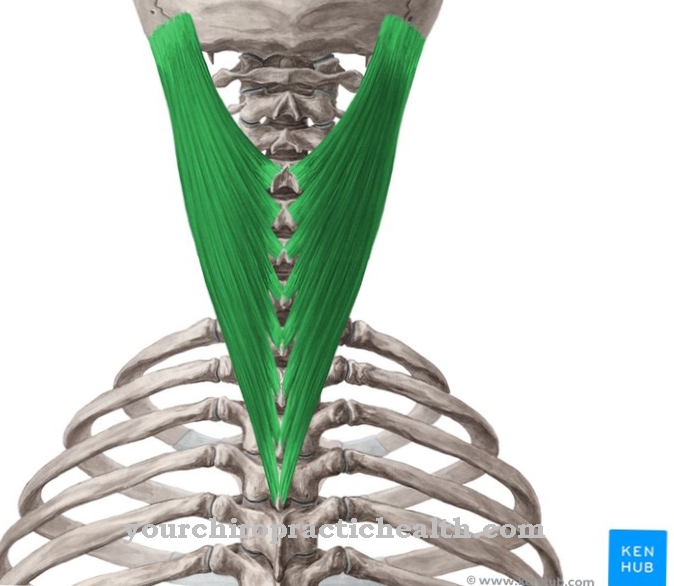The Ribonucleic acid has a similar structure to deoxyribonucleic acid (DNA). As a carrier of genetic information, however, it only plays a subordinate role. As a buffer for information, it serves, among other things, as a translator and transmitter of the genetic code from DNA to protein.
What is Ribonucleic Acid?
Ribonucleic acid is abbreviated in both English and German as RNA designated. Its structure is similar to that of DNA (deoxyribonucleic acid). In contrast to DNA, however, it only consists of one strand. Their task is, among other things, the transmission and translation of the genetic code in protein biosynthesis.
However, the RNA occurs in different forms and also fulfills different tasks. Shorter RNA molecules have no genetic code at all, but are responsible for the transport of certain amino acids. Ribonucleic acid is not as stable as DNA because it has no long-term storage function for the genetic code. In the case of mRNA, for example, it only serves as a buffer until the transmission and translation has been completed.
Anatomy & structure
Ribonucleic acid is a chain composed of many nucleotides. The nucleotide consists of a connection between phosphate residue, sugar and nitrogen base. The nitrogen bases adenine, guanine, cytosine and uracil are each bound to a sugar residue (ribose). The sugar is in turn esterified in two places with a phosphate residue and forms a bridge with it.
The nitrogen base is in the opposite position from the sugar. Sugar and phosphate residues alternate and form a chain. The nitrogen bases are therefore not directly linked to one another, but sit on the side of the sugar. Three consecutive nitrogen bases are called triplets and contain the genetic code for a specific amino acid. Several triplets in a row encode a polypeptide or protein chain.
In contrast to DNA, the sugar contains a hydroxyl group at the 2 'position instead of a hydrogen atom. In addition, the nitrogen base thymine is exchanged for uracil in the RNA. Because of these small chemical deviations, RNA, in contrast to DNA, is usually only single-stranded. The hydroxyl group in ribose also ensures that ribonucleic acid is not as stable as DNA. The assembly and disassembly must be flexible because the information to be transmitted is constantly changing.
Function & tasks
Ribonucleic acid fulfills several tasks. As a long-term memory for the genetic code, it is usually out of the question. Only in some viruses does the RNA serve as a carrier for genetic information. In the other living beings this task is taken over by the DNA. The RNA functions, among other things, as a transmitter and translator of the genetic code in protein biosynthesis.
The mRNA is responsible for this. Translated, mRNA means messenger RNA or messenger RNA. It copies the information on a gene and transports it to the ribosome, where a protein is synthesized using this information. Three adjacent nucleotides form a so-called codon, which represents a certain amino acid. In this way, a polypeptide chain of amino acids is gradually built up. The individual amino acids are transported to the ribosome by means of the tRNA (transfer RNA). The tRNA thus functions as an auxiliary molecule in protein biosynthesis. As another RNA molecule, rRNA (ribosomal RNA) is involved in the structure of the ribosomes.
Further examples are the asRNA (antisense RNA) for the regulation of gene expression, the hnRNA (heterogeneous nuclear RNA) as a precursor to mature mRNA, the ribowitches for gene regulation, the ribozymes for the catalysis of biochemical reactions and many more. The RNA molecules must not be stable because different transcripts are needed at different times. The split off nucleotides or oligomers are constantly used for the new synthesis of RNA. According to Walter Gilbert's RNA world hypothesis, the RNA molecules formed the precursors of all organisms. Even today they are the only carriers of the genetic code of some viruses.
Diseases
In connection with diseases, ribonucleic acids play a role insofar as many viruses only have RNA as their genetic material. In addition to DNA viruses, there are also viruses with single- or double-stranded RNA. Outside a living organism, a virus is completely inactive. It does not have its own metabolism. However, if a virus comes into contact with body cells, the genetic information of its DNA or RNA is activated. The virus begins to multiply itself with the help of the host cell's organelles.
The host cell is reprogrammed by the virus to produce individual virus components. The genetic material of the virus gets into the cell nucleus. It is there that it is incorporated into the host cell's DNA, with new viruses being constantly generated. The viruses are discharged from the cell. The process repeats itself until the cell dies. In the case of RNA viruses, the genetic information of the RNA is transcribed into the DNA using the enzyme reverse transcriptase. Retroviruses are a special form of RNA viruses. For example, the HI virus is one of the retroviruses. In retroviruses, too, the enzyme reverse transcriptase ensures the transfer of the genetic information of the single-stranded RNA into the DNA of the host cell.
There new viruses are generated which leave the cell without being destroyed. New viruses are constantly forming, which constantly attack other cells. Retroviruses are very susceptible to mutation and are therefore difficult to fight. A combination of several components such as reverse transcriptase inhibitors and protease inhibitors is used as therapy.









.jpg)



.jpg)



.jpg)







.jpg)


